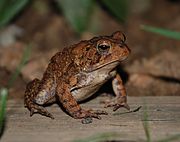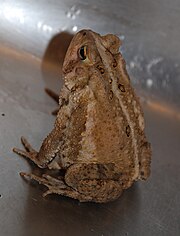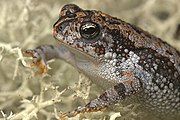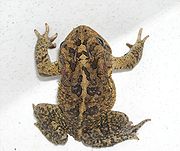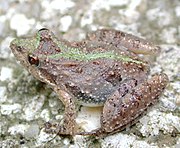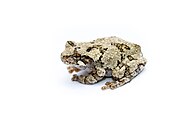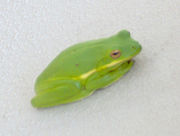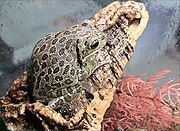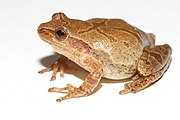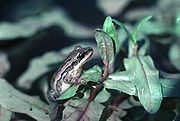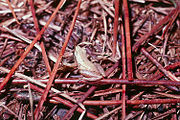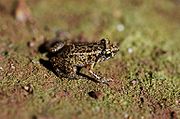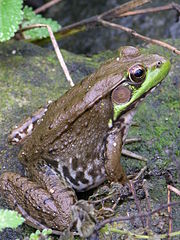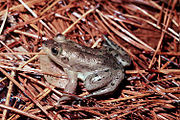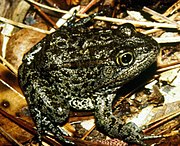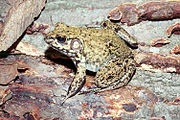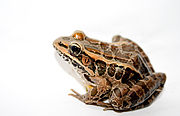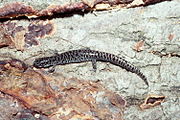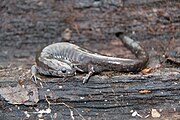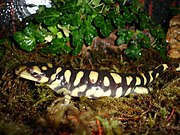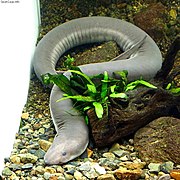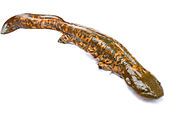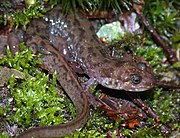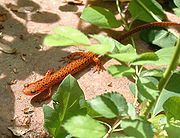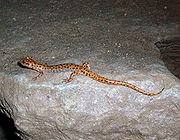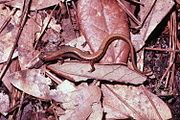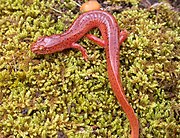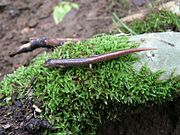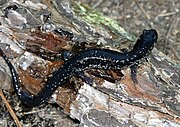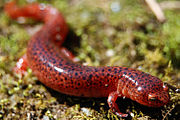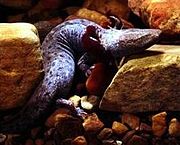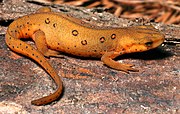
Amphibians are ectothermic, anamniotic, four-limbed vertebrate animals that constitute the class Amphibia. In its broadest sense, it is a paraphyletic group encompassing all tetrapods excluding the amniotes. All extant (living) amphibians belong to the monophyletic subclass Lissamphibia, with three living orders: Anura, Urodela (salamanders), and Gymnophiona (caecilians). Evolved to be mostly semiaquatic, amphibians have adapted to inhabit a wide variety of habitats, with most species living in freshwater, wetland or terrestrial ecosystems. Their life cycle typically starts out as aquatic larvae with gills known as tadpoles, but some species have developed behavioural adaptations to bypass this.

The hellbender, also known as the hellbender salamander, is a species of aquatic giant salamander endemic to the eastern and central United States. It is the largest salamander in North America. A member of the family Cryptobranchidae, the hellbender is the only extant member of the genus Cryptobranchus. Other closely related salamanders in the same family are in the genus Andrias, which contains the Japanese and Chinese giant salamanders. The hellbender is much larger than any other salamander in its geographic range, and employs an unusual adaption for respiration through cutaneous gas exchange via capillaries found in its lateral skin folds. It fills a particular niche – both as a predator and prey – in its ecosystem, which either it or its ancestors have occupied for around 65 million years. The species is listed as Vulnerable on the IUCN Red List of Threatened Species due to the impacts of disease and widespread habitat loss and degradation throughout much of its range.
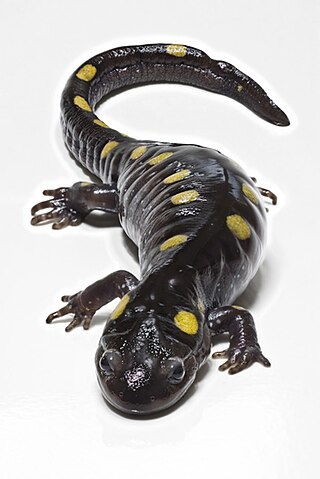
Salamanders are a group of amphibians typically characterized by their lizard-like appearance, with slender bodies, blunt snouts, short limbs projecting at right angles to the body, and the presence of a tail in both larvae and adults. All ten extant salamander families are grouped together under the order Urodela from the group Caudata. Urodela is a scientific Latin term based on the Ancient Greek οὐρά δήλη: ourà dēlē "conspicuous tail". Caudata is the Latin for "tailed ones", from cauda: "tail".
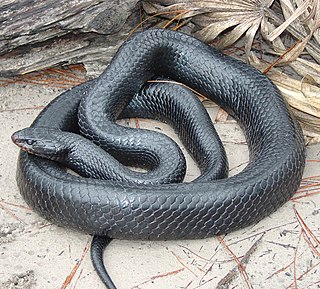
The eastern indigo snake is a species of large, non-venomous snake in the family Colubridae. Native to the southeastern United States, it is the longest native snake species in the country.

This article seeks to serve as a field-guide, central repository, and listing for the flora and fauna of the US state of North Carolina and surrounding territories.

The Red Hills salamander is a fairly large, terrestrial salamander growing to about 255 millimetres (10.0 in). Its body color is gray to brownish without markings, and its limbs are relatively short. It is the official state amphibian of Alabama, the state it is endemic to. It is the only species in the genus Phaeognathus.

Heterodon simus, commonly known as the southern hog-nosed snake, is a harmless snake species endemic to the southeastern United States. No subspecies are currently recognized.
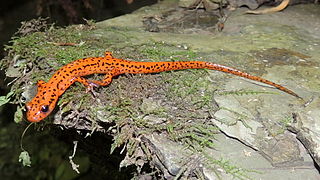
The spotted-tail or spotted-tailed salamander is a species of brook salamander in the family Plethodontidae. This species is, somewhat vaguely, referred to by the common name of 'cave salamander'; however, it is not restricted to dwelling inside deep caverns, but is known for inhabiting surface-level, terrestrial, woodland habitats, as well. More often than not, the common name 'cave salamander' refers to the "true" cave salamanders, such as the olm of Europe. It is rarely used to refer to the axolotl, another species which, like the olm, inhabits caves that never see daylight, thus lacking skin pigment and having extremely poor eyesight when compared with the vivid orange and bright-eyed spotted-tail salamander. Additionally, true cave salamanders, including the olm, spend their entire lives as fully-aquatic amphibians, while the spotted-tail salamander is not limited to an exclusively amphibious lifestyle.
The reticulated flatwoods salamander is a species of mole salamander, an amphibian in the family Ambystomatidae. The species is native to a small portion of the southeastern coastal plain of the United States in the western panhandle of Florida and extreme southwestern Georgia. The species once occurred in portions of southern Alabama but is now considered extirpated there. Its ecology and life history are nearly identical to its sister species, the frosted flatwoods salamander. A. bishopi inhabits seasonally wet pine flatwoods and pine savannas west of the Apalachicola River-Flint River system. The fire ecology of longleaf pine savannas is well-known, but there is less information on natural fire frequencies of wetland habitats in this region. Like the frosted flatwoods salamander, the reticulated flatwoods salamander breeds in ephemeral wetlands with extensive emergent vegetation, probably maintained by summer fires. Wetlands overgrown with woody shrubs are less likely to support breeding populations.
J. Whitfield "Whit" Gibbons is an American herpetologist, author, and educator. He is Professor Emeritus of Ecology, University of Georgia, and former Head of the Environmental Outreach and Education program at the Savannah River Ecology Laboratory (SREL).
Bascombe Well Conservation Park, formerly known as Bascombe Well National Park, is a protected area in the Australian state of South Australia located on Eyre Peninsula in the gazetted localities of Kappawanta and Murdinga about 115 kilometres (71 mi) north of Port Lincoln and about 25 kilometres (16 mi) south-west of Lock.

Florida hosts many types of fauna. From coral reefs of the Florida Keys to the cypress swamps of the Panhandle, the state's diverse habitats are home to a variety of wildlife. Florida is among the top five states in terms of endemic species. There are over 700 terrestrial animals, 200 freshwater fish species, 1,000 marine fish and thousands of terrestrial insects and other invertebrates that inhabit the state. Florida's peninsular geography spans from subtropical to tropical zones, which, combined with its distinctive geology and climate, contribute to habitat diversity and an array of species. The native wildlife that exists in the state are of temperate and tropical origin.
